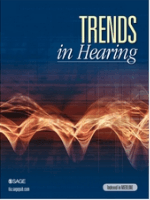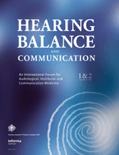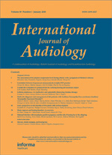
Trends in Hearing
Scope & Guideline
Pioneering insights for a sound future.
Introduction
Aims and Scopes
- Hearing Loss and Rehabilitation:
The journal emphasizes studies that explore the prevalence, characteristics, and management of hearing loss, including the effectiveness of various hearing aids and cochlear implants. - Cognitive and Auditory Processing:
Research investigating the interplay between cognitive functions and auditory processing is a core focus, particularly how listening effort and cognitive load affect speech perception. - Innovative Measurement Techniques:
The journal showcases advancements in auditory measurement methodologies, including the use of neural decoding, pupillometry, and functional imaging to assess auditory performance. - Listening Environments and Conditions:
Studies examining the impact of different acoustic environments on speech perception and listening effort are highlighted, including research on noise reduction strategies and spatial hearing. - Technological Innovations in Audiology:
The journal covers research on new technologies and methodologies in audiology, such as automated audiometry, virtual reality applications, and the development of personalized auditory models.
Trending and Emerging
- Listening Effort and Cognitive Load:
Research increasingly focuses on how cognitive load and listening effort affect speech perception, particularly in challenging auditory environments, reflecting a growing interest in the cognitive aspects of hearing. - Personalized Audiology:
There is a significant trend towards personalized approaches in audiology, such as tailoring hearing aids and rehabilitation strategies to individual auditory profiles and preferences. - Neural and Physiological Measures:
Emerging studies utilize advanced neural and physiological measures, including pupillometry and electrocochleography, to gain insights into auditory processing and the effectiveness of interventions. - Virtual and Augmented Reality in Auditory Testing:
The application of virtual and augmented reality technologies for auditory testing and rehabilitation is gaining traction, suggesting a future direction for immersive auditory experiences. - Impact of Environmental Factors on Hearing:
Research examining how environmental factors, such as background noise and room acoustics, influence hearing outcomes is becoming increasingly relevant, especially in real-world contexts.
Declining or Waning
- Traditional Audiometric Techniques:
There is a noticeable decline in research focusing solely on conventional audiometric testing methods, as the field shifts towards more innovative and comprehensive assessment techniques. - General Population Hearing Studies:
While studies on hearing loss prevalence remain important, there has been a decrease in the emphasis on broad population-based studies, with more focus shifting towards specific groups, such as children with cochlear implants or older adults. - Basic Mechanisms of Hearing Loss:
Research dedicated to the fundamental biological mechanisms underlying hearing loss has waned, as practical applications and technological advancements take precedence over purely theoretical studies. - Music Perception in Hearing Impairment:
The exploration of music perception specifically in hearing-impaired listeners has seen a reduction, possibly due to a shift in focus towards more clinically relevant auditory challenges. - Static Models of Auditory Processing:
There is a declining interest in static models of auditory processing, with a trend towards dynamic and interactive models that consider contextual factors influencing hearing.
Similar Journals

JOURNAL OF SPEECH LANGUAGE AND HEARING RESEARCH
Advancing the frontiers of communication science.JOURNAL OF SPEECH LANGUAGE AND HEARING RESEARCH, published by the American Speech-Language-Hearing Association, is a premier peer-reviewed journal dedicated to advancing the fields of speech, language, and hearing sciences. With an impressive impact factor and a strong ranking within the Q1 category of Linguistics and Language and Speech and Hearing, this journal serves as a vital resource for academics and professionals seeking to disseminate groundbreaking research and innovative practices in communication disorders. The journal, which spans actively from 1996 to 2024, offers Open Access options, facilitating broader distribution of knowledge within the scientific community. As evident from its esteemed rankings—such as #11/66 in Health Professions: Speech and Hearing—this journal not only drives forward the knowledge frontiers but also plays a crucial role in shaping policy and practice in health services. Researchers, clinicians, and students alike will find invaluable insights and empirically supported advancements within its pages, making it an essential publication in the landscape of communication and health research.

Egyptian Journal of Otolaryngology
Empowering scholars with high-quality ENT research.Egyptian Journal of Otolaryngology (EJOT) is a premier open access journal dedicated to advancing the field of otorhinolaryngology. Published by Springer, the journal has been an essential resource for researchers and practitioners since its transition to open access in 2012. With an ISSN of 1012-5574 and E-ISSN 2090-8539, EJOT aims to facilitate the dissemination of high-quality research, covering a broad spectrum of topics within otolaryngology. The journal's significance is underscored by its current ranking in the Q3 category of the Scopus Otorhinolaryngology category, and it is positioned in the 23rd percentile of its field, reflecting its commitment to scholarly excellence. Researchers, professionals, and students alike will find valuable insights and innovative studies in the journal's articles, contributing to ongoing education and the advancement of best practices in ear, nose, and throat medicine. The journal is based in Germany with its operations centered at ONE NEW YORK PLAZA, SUITE 4600, NEW YORK, NY 10004, UNITED STATES, ensuring a global reach in the academic community.

Hearing Balance and Communication
Bridging research and practice for better hearing and communication.Hearing Balance and Communication is a prominent peer-reviewed journal dedicated to advancing the fields of Otorhinolaryngology, Speech, and Hearing. Published by Wolters Kluwer Medknow Publications, this journal serves as a valuable resource for researchers, clinicians, and students invested in exploring the multifaceted aspects of auditory and vestibular health. With an ISSN of 2169-5717 and an E-ISSN of 2169-5725, it has established itself as a significant platform since its inception in 2013, boasting a commendable Q3 ranking in both Otorhinolaryngology and Speech and Hearing categories as of 2023. The journal emphasizes the dissemination of original research, reviews, and case studies that foster a deeper understanding of hearing and balance, as well as effective communication practices. Located in the United Kingdom, Hearing Balance and Communication is a key player in bridging research and clinical practice, ensuring that vital findings reach the professionals who can implement them in real-world settings, thus increasingly impacting patient care and public health.

JARO-JOURNAL OF THE ASSOCIATION FOR RESEARCH IN OTOLARYNGOLOGY
Exploring Innovations in Ear, Nose, and Throat MedicineJARO - Journal of the Association for Research in Otolaryngology is a premier scholarly journal dedicated to advancing research in the field of otolaryngology and sensory systems. Published by Springer, this journal aims to disseminate high-quality original research, reviews, and clinical studies that enhance the understanding of ear, nose, throat, and related structures' functions and diseases. With an ISSN of 1525-3961 and an E-ISSN of 1438-7573, JARO stands out in its category, currently ranked Q2 in Otorhinolaryngology and Q3 in Sensory Systems as per the 2023 category quartiles. The journal enjoys a respectable reputation, ranking 32nd out of 123 journals in Medicine - Otorhinolaryngology, placing it in the 74th percentile, and holds a rank of 19th out of 42 in the field of Neuroscience - Sensory Systems. Although it does not follow an Open Access model, JARO remains a key resource for researchers, clinicians, and students alike, facilitating the exchange of ideas and research outcomes that contribute to the evolution of practices and technologies in the fields it serves. Addressed from One New York Plaza, Suite 4600, New York, NY 10004, United States, JARO is committed to fostering innovative advancements in otolaryngology.

Auditory and Vestibular Research
Advancing Knowledge in Auditory and Vestibular SciencesAuditory and Vestibular Research is an esteemed open-access journal published by Tehran University of Medical Sciences, dedicated to advancing the field of otorhinolaryngology and speech and hearing sciences. Established to foster scholarly communication, this journal has gained traction since its inception and has been openly accessible since 2015, encouraging a wider dissemination of research findings. With an E-ISSN of 2423-480X, it features a diverse range of studies and reviews that reflect the latest advancements and methodologies in auditory and vestibular functioning. As of 2023, the journal is ranked Q3 in both Otorhinolaryngology and Speech and Hearing categories, indicating a growing significance within the academic landscape, especially among researchers and healthcare professionals focusing on auditory health. By publishing quality research and facilitating dialogue within the community, Auditory and Vestibular Research plays a crucial role in informing practice and enhancing knowledge in these vital areas of medicine.

HEARING RESEARCH
Exploring the depths of hearing and its complexities.HEARING RESEARCH, published by Elsevier, is a premier journal in the field of sensory systems, focusing on the multifaceted aspects of hearing, including auditory function, pathology, and rehabilitation. Established in 1978, it has continuously contributed to the advancement of auditory science, making it a vital resource for researchers, professionals, and students looking to expand their understanding of auditory mechanisms and disorders. With an impressive Scopus ranking of #12 out of 42 in the Neuroscience: Sensory Systems category, and a notable impact factor placing it in the Q2 quartile for 2023, the journal showcases rigorous, peer-reviewed research that drives innovation and informs clinical practice. Though it does not offer open access options, its significant contributions to the field are accessible to those affiliated with institutions worldwide. Located in Amsterdam, Netherlands, HEARING RESEARCH stands at the forefront of auditory research, fostering scholarly dialogue and enhancing knowledge in this crucial area of neuroscience.

Audiology Research
Empowering the Audiology Community with KnowledgeAudiology Research, published by MDPI, is a reputable open-access journal since 2011, dedicated to advancing the field of audiology through the dissemination of high-quality research. With ISSN 2039-4330 and E-ISSN 2039-4349, the journal serves a global audience from its base in Basel, Switzerland, and operates under rigorous peer-review standards to ensure the integrity of published content. With a 2023 Impact Factor placing it in the Q2 category for both Otorhinolaryngology and Podiatry, Audiology Research has established itself as a significant platform for researchers, professionals, and students seeking to explore various aspects of hearing science, auditory disorders, and rehabilitative practices. Its commitment to open access fosters wider dissemination and accessibility of research findings, thereby promoting interdisciplinary collaboration and enhancing patient outcomes within the audiology community. The journal's alignment with major indexing databases, alongside its Scopus ranks—#4 in Health Professions: Podiatry and #65 in Medicine: Otorhinolaryngology—reflects its growing influence and dedication to impactful contributions in the health sciences.

INTERNATIONAL JOURNAL OF AUDIOLOGY
Advancing the frontiers of hearing science.International Journal of Audiology, published by Taylor & Francis Ltd, is a premier scholarly journal that serves as a vital resource for researchers and professionals in the fields of linguistics, language, and audiology. With an impressive Q1 ranking in both Speech and Hearing and Linguistics categories, this journal has established itself as a leader in disseminating cutting-edge research, fostering innovation, and enhancing clinical practices since its inception in 1962. The journal’s commitment to Open Access ensures wider visibility and impact of the published work, enabling broader discussions within the academic community and clinical settings alike. With a global readership, the International Journal of Audiology provides a platform for high-quality studies and reviews that address contemporary challenges and advances in hearing sciences. By prioritizing rigorous peer-review standards and maintaining high publication ethics, the journal not only supports academic discourse but also contributes significantly to the evidence-based practice essential for improving patient outcomes.

Laryngoscope Investigative Otolaryngology
Elevating Standards in Otolaryngology and SurgeryLaryngoscope Investigative Otolaryngology is a prominent open access journal published by Wiley, dedicated to advancing research and knowledge within the field of otolaryngology and surgical practices. Since its inception in 2016, this journal has undergone a transformative phase and has quickly established itself in the academic community, achieving Q2 quartile rankings in both Otorhinolaryngology and Surgery for the year 2023. With an ISSN of 2378-8038, it serves as a vital repository of innovative research, insights, and reviews, catering primarily to researchers, medical professionals, and students. The journal emphasizes accessibility, allowing wide dissemination of pivotal findings essential for fostering collaboration and enhancing clinical practices. Through its rigorous peer-review process and commitment to quality, Laryngoscope Investigative Otolaryngology seeks to contribute significantly to the ongoing dialogue and improvements within the health care landscape.

ACTA ACUSTICA
Pioneering Research in Acoustics and UltrasonicsACTA ACUSTICA, published by EDP SCIENCES S A, is an esteemed open access journal dedicated to advancing the fields of Acoustics and Ultrasonics, Computer Science Applications, Electrical and Electronic Engineering, as well as Speech and Hearing. Since its transition to open access in 2020, this journal has provided a platform for high-quality research that is freely accessible to scholars, practitioners, and students alike. With a respectable categorization in Q3 across multiple disciplines as of 2023, it reflects the ongoing commitment to disseminating relevant findings and innovations within these fields. Researchers interested in meaninful contributions to acoustic science will find ACTA ACUSTICA to be an invaluable resource that encourages collaboration and knowledge sharing, thereby fostering advancements that resonate across academia and industry. The journal aims to publish results that enhance understanding of sound phenomena and their applications, positioning itself as a pivotal channel for academic discourse.